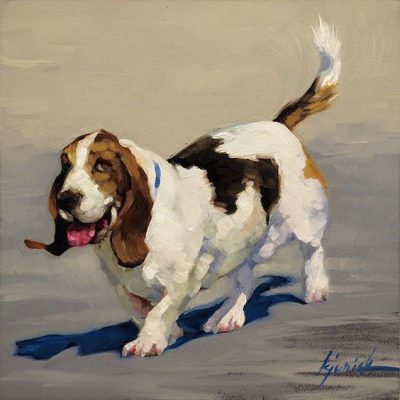
“My hounds are bred out of the Spartan kind,
So flewed, so sanded, and their heads are hung
With ears that sweep away the morning dew,
Crook-kneed, and dew-lapped like Thessalian bulls,
Slow in pursuit, but matched in mouth like bells,
Each under each. A cry more tunable
Was never hollaed to, nor cheered with horn,
In Crete, in Sparta, nor in Thessaly.
Judge when you hear.
(sees the four sleeping lovers)
But, soft! What nymphs are these?”
Fans of the Bard recognize this as a speech by Theseus, the Duke of Athens in A Midsummer Night’s Dream. A site that translates Shakespeare into modern text did it this way:
“My dogs are bred from Spartan hounds.
They have the same folds of flesh around their mouths, the same sandy-colored fur, and hanging ears that brush the morning dew off the grass.
They have crooked knees and folds of skin under their necks, just like the Spartan hounds.
They’re not very fast in the chase, but their barking sounds like bells ringing.
Each bark is perfectly in tune with the others, like notes on a scale.
No one, anywhere, has ever gone hunting with a more musical pack of dogs.”
Whether you understand the old verse, or needed to read the modern version, we’re betting you’ve guessed the either could only be describing the Basset Hound. You’d be wrong, however, if you think that hunting with Bassets went the way of Shakespeare, which is to say, dead and buried. In 2014, two new Hound packs were formed in the UK (each registered with the MBHA, or Masters of Basset Hounds Association: One was the Moorlands Foxhounds in Derbyshire, but the other was the Woolaston Bassets. This brings, to our knowledge, a total of ten packs registered with the Association, including one in the United States and one in Spain.
In France, Basset breeds were used in the “chasse a tir,” or flushing game to guns, and it’s said that a Basset Hound’s sense of smell for tracking is second only to that of the Bloodhound. But why hunt over a dog that won’t break any speed records?
Why not?
Yes, the Bassets are slow, methodical movers, but this is ideal for people hunting on foot, and those who like to be able to keep up with the hounds and watch them work. As low slung dogs, the breed is well suited for working in dense cover, and anyone who’s ever heard a Basset Hound bark and/or bay knows how their voice carries which means that hunters know where the hounds are, which way they’re going, and that they won’t get there too fast.
If the subject interests you, look for the only book we know of devoted to hunting with Bassets in the UK, and that’s, “A Bother of Bassets” by Dr. Brian Wilson (not to be confused with the Beach Boy).
“Happy Basset Hound on the Beach, Hilton Head Island, SC” by Karen Jurick was sold on Ebay in 2014, but you can see more of her delightful dog pieces here.

I love that passage and even if you need the modernization for understanding I hope you embrace the music of the original.
You said the right word, Linda. “Music.” Language IS music. It has cadence, nuance and more. We absolutely appreciate the original.